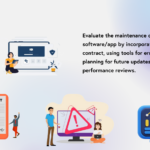Introduction
As a founder, whether you have a technical or non-technical background, one of the biggest fears is realizing that your software or mobile app has misunderstood market needs. This can lead to low engagement, poor adoption rates, and ultimately, the failure of your product. Understanding and aligning with market needs is crucial for the success of any digital product. This comprehensive guide will help you identify if your product has missed the mark and provide actionable steps to get back on track.
Low User Engagement:
Low user engagement is often the first sign that your product is not resonating with the market. Metrics like short session durations, high bounce rates, and lack of repeat usage can indicate that users do not find your app valuable or engaging.
- Indicators: Short session durations, high bounce rates, low repeat usage.
- Examples: Apps with high download rates but low active user numbers.

Negative Feedback and Reviews:
Consistent negative feedback and poor reviews can be a clear signal that your product does not meet user expectations. It’s essential to analyze this feedback to understand the specific issues users are facing.
- Common Feedback: Users might express confusion, frustration, or disappointment.
- Actionable Steps: Regularly monitor and respond to reviews, and use this feedback to guide product improvements.

High Uninstall Rate:
If a significant number of users uninstall your app shortly after downloading it, it indicates a disconnect between user expectations and the actual experience.
- Indicators: High uninstall rate within the first week of download.
- Reasons: Poor user experience, irrelevant features, or performance issues.

Conducting Effective Market Research:
Pre-Launch Market Research
Before launching your product, it’s crucial to conduct thorough market research to understand your target audience and their needs. This can involve surveys, focus groups, and analyzing market trends.
- Methods: Surveys, focus groups, market analysis.
- Tools: Google Trends, SurveyMonkey, focus group discussions.
Post-Launch Market Research
Market research shouldn’t stop after the launch. Continuously gather data to understand how users interact with your product and how their needs evolve.
- Methods: User surveys, analytics tools, feedback forms.
- Tools: Google Analytics, Hotjar, user interviews.
Analyzing Competitors
Understanding your competitors’ strengths and weaknesses can provide valuable insights. Analyze their products, user feedback, and market positioning.
- Steps: Identify key competitors, analyze their user reviews, compare feature sets.
- Tools: SWOT analysis, competitive benchmarking tools.

Gathering and Utilizing User Feedback:
Collecting Feedback
Effective feedback collection is crucial for understanding user needs and pain points. Utilize multiple channels to gather comprehensive feedback.
- Channels: In-app surveys, app store reviews, social media.
- Best Practices: Encourage honest feedback, make it easy for users to provide feedback.
Analyzing Feedback
Categorize and analyze feedback to identify common themes and recurring issues. Use this information to prioritize improvements.
- Techniques: Text analysis, sentiment analysis.
- Tools: Feedback management tools like Zendesk, Qualtrics.
Implementing Changes
Use the insights gained from feedback to make informed decisions about product updates. Prioritize changes that will have the most significant impact on user satisfaction and engagement.
- Steps: Prioritize issues, develop a roadmap, implement changes iteratively.
- Examples: Case studies of successful product pivots based on user feedback.

Pivoting Your Product Strategy:
When to Pivot
Knowing when to pivot is crucial. If you consistently see signs of misalignment with market needs, it might be time to consider a pivot.
- Indicators: Persistent low engagement, negative feedback, poor adoption rates.
- Types of Pivots: Feature pivot, market pivot, business model pivot.
Steps to Pivot Successfully
Planning and executing a pivot requires careful strategy. Involve stakeholders, communicate changes clearly, and monitor the impact closely.
- Steps: Conduct thorough analysis, develop a pivot strategy, communicate with users and stakeholders.
- Examples: Successful pivots in the tech industry.

Continuous Improvement and Iteration:
Agile Development
Adopting agile methodologies allows for continuous improvement and quick adaptation to user feedback. Regularly iterate on your product based on user needs.
- Benefits: Flexibility, faster delivery, continuous user feedback.
- Practices: Scrum, Kanban.
Monitoring and Evaluation
Continuously monitor key performance indicators (KPIs) to evaluate the success of your product. Adjust strategies based on these insights.
- KPIs: User engagement metrics, customer satisfaction scores, retention rates.
- Tools: Google Analytics, Mixpanel.
User Involvement
Keeping users involved in the development process ensures that your product evolves according to their needs. Implement user testing and beta programs.
- Strategies: User testing, beta programs, user feedback loops.
- Benefits: Improved user satisfaction, better product alignment with market needs.

Conclusion
Recap of Key Points
- Understanding market needs is critical for the success of your software or app.
- Regularly monitor engagement metrics, gather feedback, and conduct market research to ensure alignment with user needs.
Get in touch with us today to know how we could help you boost engagement on your App or Digital Product.









